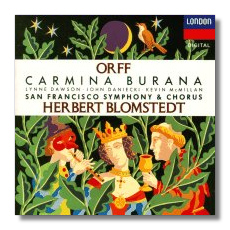
The Internet's Premier Classical Music Source
Related Links
- Orff Reviews
- Latest Reviews
- More Reviews
-
By Composer
-
Collections
DVD & Blu-ray
Books
Concert Reviews
Articles/Interviews
Software
Audio
Search Amazon
Recommended Links
Site News
 CD Review
CD Review
Carl Orff

Carmina Burana
Lynne Dawson, soprano
John Daniecki, tenor
Kevin McMillan, baritone
San Francisco Symphony & Chorus/Herbert Blomstedt
Vance George, chorus director
London 430509-2 DDD 58:12
After a spate of Nielsen and Sibelius symphonies, Blomstedt and his corp of musical engineers have turned their Apollonian literality on an unlikely score, Carl Orff's sybaritic masterpiece, Carmina Burana (1937). The result is a steely, ferocious reading. The famous Fortuna choruses, which girdle the twenty-five Latin and German scenic poems, have an icy, menacing fullness; it's a performance in the Heifetz vein, with Blomstedt's hair-trigger directions executed with ease and to the limits of virtuosity. I'd like to see this ensemble in another 20th Century classic program: Stravinsky's Pétrouchka and Rite of Spring. Another mainstay, Bartók's Concerto for Orchestra, brought the house down at Davies when I heard it.
To the shining moments of the work at hand. The brass and percussion accelerandi (track 2) are a marvel, their sparkle benefitting from studio-like miking. For that matter, none of the performers is given short shrift, except perhaps the soloists, who lack the extremely close pickups evident in the Shaw/Atlanta Symphony recording (Telarc CD-80056). This can be remedied by turning up the volume.
If Orff's rhythmic ostinatos sometimes sound like heavy-handed Stravinsky, he does carry off a hilarious bit of mock Italian opera, Estuans interius, which introduces the "Tavern" scenes. Baritone Kevin McMillan's small, agile voice and precise diction are more appropriate than the Wagnerian thunder of Håkan Hagegård (the Telarc disc).
Lynne Dawson attacks the daunting soprano solos in the Court of Love section without hesitation; she doesn't have the silvery boyish quality of a Judith Blegen, but her vibrato has its own eerie effect. After the sensuality of those moments, the reprise of "Fortune" comes like black cloud, reminding us of the essential arbitrariness of existence.
Copyright © 1997, Robert J. Sullivan


















